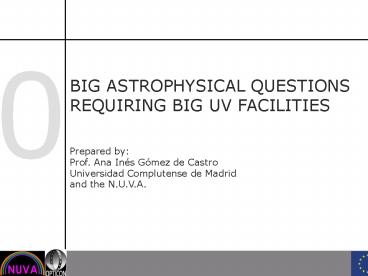Network for UltraViolet Astronomy PowerPoint PPT Presentation
1 / 15
Title: Network for UltraViolet Astronomy
1
0
BIG ASTROPHYSICAL QUESTIONS REQUIRING BIG UV
FACILITIES Prepared by Prof. Ana Inés Gómez
de Castro Universidad Complutense de Madrid and
the N.U.V.A.
2
SOME THOUGHTS to begin with
1
BRIEF ACCOUNTING ON THE WORK CARRIED OUT BY THE
N.U.V.A. TEAM IN THE LAST 4 YEARS. N.U.V.A. IS
THE EUROPEAN NETWORK FOR UV ASTRONOMY WITH STRONG
CONNECTIONS RUSSIA, USA, CHINA, INDIA THIS
MEETING IS ABOUT FACILITIES (RD INVESTMENTS) TO
APPROACH SUCCESSFULLY THE MOST RELEVANT PROBLEMS
IN MODERN ASTROPHYSICS THIS REQUIRES A
MULTIWAVELENGTH APPROACH AND UV MAKES IT BETTER
THAN OTHER SPECTRAL RANGES FOR SOME SPECIFIC
PURPOSES.
3
BIG QUESTIONS REQUIRING BIG UV FACILITIES
Q1 Q2 Q3
Q-1
- Q1 WHAT is the distribution of diffuse baryonic
matter in the Universe (up to z2), its physical
properties and its chemical composition/enrichment
?. Which role does it play in galaxy formation? - Q2 WHAT is the composition and properties of the
atmospheres of extrasolar planets? and, How
dependent is the chemistry on the initial
planetary forming conditions? - Q3 HOW do astrophysical disks evolve? Which role
does the interaction between the disk and the
source of gravity play in driving the observed
outflows? And, How do astrophysical disk evolve
when they become passive? (especially in
protoplanetary systems)
Q-2
Q-3
4
BIG QUESTIONS REQUIRING BIG UV FACILITIES
Q1 Q2 Q3
Q-1
- Major epoch of galaxy assembly and metal
production z 0 -1.5 - Numerical simulations show that IGM gas is
distributed - Warm photoionized gas (104 K)
- Warm/hot shocked gas (105-7 K)
- Collapsed halos, galaxies, and clusters (T gt 107
K). - UV lines are 500-1000 times more sensitive than
their x-ray counterparts.
5
BIG QUESTIONS REQUIRING BIG UV FACILITIES
Q1 Q2 Q3
Q-1
ARE LARGE GAS DEPOSITS ASSOCIATED WITH THE GREAT
WALL? WITH BUBBLES?
Critical factor -gt background targets (at V
19-21) _at_ V 21 QSO populations spatial density
(1 QSO/ 5 arcmin) INTEGRAL FIELD SPECTROSCOPY
6
BIG QUESTIONS REQUIRING BIG UV FACILITIES
Q1 Q2 Q3
Q-2
Hot Jupiters properties, stability and formation.
Connection with close binary formation. Planetary
magnetospheres. Young Planetary disks and
comets swarms. Detection of Earth like
planets. For a given aperture UV provides 10
times better resolution than IR (J-band).
HD209458b
7
BIG QUESTIONS REQUIRING BIG UV FACILITIES
Q1 Q2 Q3
Q-2
Critical factors -gt Identification of systems
with transiting planets Corot, Kepler, GAIA
(V10-13mag). -gt Spatial resolution 10mas and
dynamic range gt108 to resolve Earth-like planets
from nearby (d50 pc K7 stars).
8
BIG QUESTIONS REQUIRING BIG UV FACILITIES
Q1 Q2 Q3
Q-3
with disk dynamo
In Solar System precursors, the release of
gravitational energy into high energy radiation
is directly observable from 1 Myr on Numerical
simulations show that magnetic field is build up
and dissipated in the process. This produces
high energy particles and radiation that
propagate into the disk modifying its properties.
without disk dynamo
9
BIG QUESTIONS REQUIRING BIG UV FACILITIES
Q1 Q2 Q3
Q-3
THE STAR FORMATION BELT
Critical factors -gt V13-15 to reach the Star
Formation Belt with Rgt20,000 and integration
times lt 300 s for key COOL STARS -gt Spatial
resolution gt1mas to resolve the jet formation
region SIMILAR TO RESOLVE AGNs DISKS AT 50Mpc
10
Plan a road map
2010-2025 gt2025
The next decade The European Union astronomical
community will have access to HST
instrumentation through ESA participation in the
project. Members of the NUVA have been actively
involved in promoting the WSO-UV Observatory an
international collaboration involving Germany,
Spain, China, Ukraine and led by Russia to build,
launch and operate a 1.7m ultraviolet telescope
with spectroscopic and imaging capabilities. This
facility will be launched in 2012 and will be the
only mission working at the UV range after HST is
decommissioned. 40 of the WSO-UV time (after
the first 2 years) will be open to the World-Wide
scientific community.
11
Plan a road map
2010-2025 gt2025
The next decade Major investments are needed in
UV detectors and coatings. RD on detectors and
efficient optical elements (filters coatings,
gratings) is needed. As a result a factor of 5
increase in the instruments throughput is
expected(). An application for an ITN on UV
astronomy will be submitted to FP7 for scientific
preparation for WSO and detectors/coatings
research () Major improvements are needed in
the FUV (120nm) (the effective area drops by a
factor of 103 in this limit)
12
2010-2025 gt2025
Plan a road map
gt2025 LARGE ULTRAVIOLET MISSION. .
Key technology Robotic co-alignment of the
individual segments and alignment with the rest
of the optical system to achieve the required
image quality
MUST concept 10-m telescope 16.5 Tn
13
2010-2025 gt2025
Plan a road map
gt2025 TWO COMPONENTS FLYING FORMATION
TELESCOPE Focusing by difraction
Key technology Ionic engines for a long living
facility
14
2010-2025 gt2025
Plan a road map
Log dynamic range
1/4 of the field represented
Position in the field (resolution elements units)
15
2010-2025 gt2025
Plan a road map

